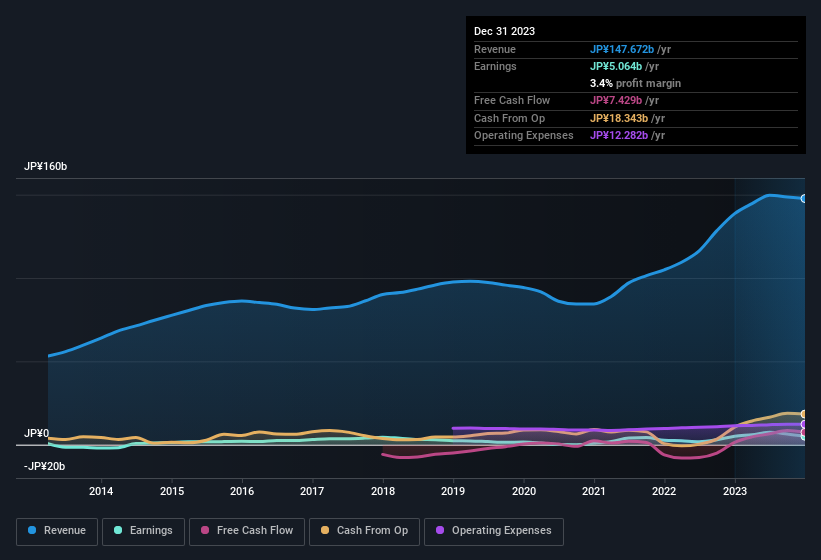- Japan
- /
- Electronic Equipment and Components
- /
- TSE:6817
Sumida (TSE:6817) Strong Profits May Be Masking Some Underlying Issues
Sumida Corporation's (TSE:6817) healthy profit numbers didn't contain any surprises for investors. We believe that shareholders have noticed some concerning factors beyond the statutory profit numbers.
View our latest analysis for Sumida

In order to understand the potential for per share returns, it is essential to consider how much a company is diluting shareholders. As it happens, Sumida issued 20% more new shares over the last year. As a result, its net income is now split between a greater number of shares. To celebrate net income while ignoring dilution is like rejoicing because you have a single slice of a larger pizza, but ignoring the fact that the pizza is now cut into many more slices. Check out Sumida's historical EPS growth by clicking on this link.
How Is Dilution Impacting Sumida's Earnings Per Share (EPS)?
As you can see above, Sumida has been growing its net income over the last few years, with an annualized gain of 512% over three years. But EPS was only up 449% per year, in the exact same period. While we did see a very small decrease, net profit was basically flat over the last year. In contrast, earnings per share are actually down a full 11%, over the last twelve months. Therefore, the dilution is having a noteworthy influence on shareholder returns.
In the long term, if Sumida's earnings per share can increase, then the share price should too. But on the other hand, we'd be far less excited to learn profit (but not EPS) was improving. For the ordinary retail shareholder, EPS is a great measure to check your hypothetical "share" of the company's profit.
Note: we always recommend investors check balance sheet strength. Click here to be taken to our balance sheet analysis of Sumida.
Our Take On Sumida's Profit Performance
Over the last year Sumida issued new shares and so, there's a noteworthy divergence between EPS and net income growth. Because of this, we think that it may be that Sumida's statutory profits are better than its underlying earnings power. But the good news is that its EPS growth over the last three years has been very impressive. Of course, we've only just scratched the surface when it comes to analysing its earnings; one could also consider margins, forecast growth, and return on investment, among other factors. If you'd like to know more about Sumida as a business, it's important to be aware of any risks it's facing. While conducting our analysis, we found that Sumida has 3 warning signs and it would be unwise to ignore them.
This note has only looked at a single factor that sheds light on the nature of Sumida's profit. But there are plenty of other ways to inform your opinion of a company. For example, many people consider a high return on equity as an indication of favorable business economics, while others like to 'follow the money' and search out stocks that insiders are buying. While it might take a little research on your behalf, you may find this free collection of companies boasting high return on equity, or this list of stocks that insiders are buying to be useful.
New: Manage All Your Stock Portfolios in One Place
We've created the ultimate portfolio companion for stock investors, and it's free.
• Connect an unlimited number of Portfolios and see your total in one currency
• Be alerted to new Warning Signs or Risks via email or mobile
• Track the Fair Value of your stocks
Have feedback on this article? Concerned about the content? Get in touch with us directly. Alternatively, email editorial-team (at) simplywallst.com.
This article by Simply Wall St is general in nature. We provide commentary based on historical data and analyst forecasts only using an unbiased methodology and our articles are not intended to be financial advice. It does not constitute a recommendation to buy or sell any stock, and does not take account of your objectives, or your financial situation. We aim to bring you long-term focused analysis driven by fundamental data. Note that our analysis may not factor in the latest price-sensitive company announcements or qualitative material. Simply Wall St has no position in any stocks mentioned.
About TSE:6817
Sumida
Designs, manufactures, and sells electronic components and modules for consumer electronics, automotive, and industrial application in Japan, rest of Asia, Europe, and North America.
Established dividend payer with proven track record.
Similar Companies
Market Insights
Community Narratives


Recently Updated Narratives


MINISO's fair value is projected at 26.69 with an anticipated PE ratio shift of 20x


The Quiet Giant That Became AI’s Power Grid


Nova Ljubljanska Banka d.d will expect a 11.2% revenue boost driving future growth
Popular Narratives


The company that turned a verb into a global necessity and basically runs the modern internet, digital ads, smartphones, maps, and AI.


MicroVision will explode future revenue by 380.37% with a vision towards success



